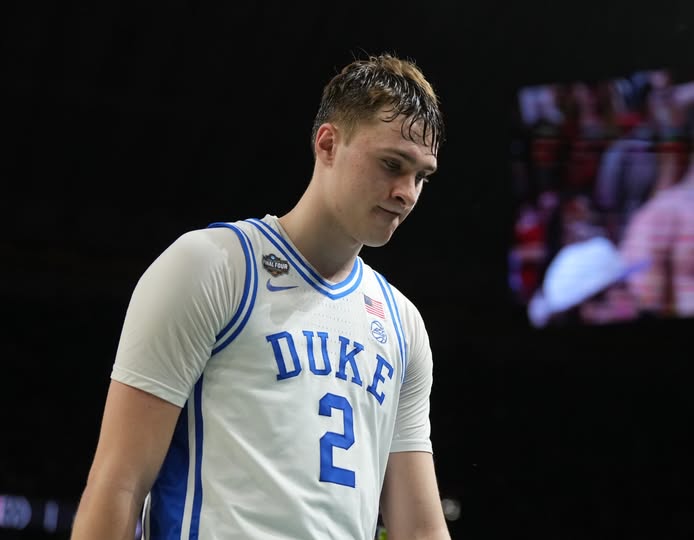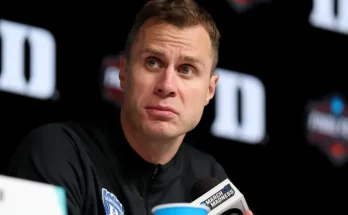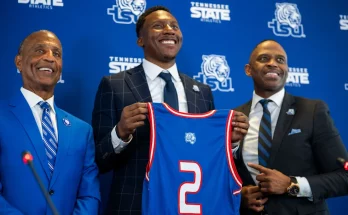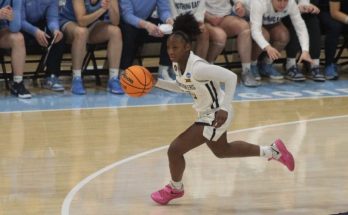Blue Blood Exodus: Cooper Flagg’s NBA Leap Signals a Historic Shift in College Basketball
When Cooper Flagg officially announced his decision to declare for the 2025 NBA Draft, it sent shockwaves through the college basketball world—not because his departure was unexpected, but because of what it represents: the beginning of a seismic shift in the power dynamic of NCAA basketball’s most storied programs. The departure of Flagg after just one season at Duke is more than a singular headline—it’s a turning point that marks the acceleration of what many are calling a “Blue Blood Exodus.”
For decades, blue bloods like Duke, Kentucky, North Carolina, and Kansas dominated the hardwood with top-tier talent, national TV exposure, and deep tournament runs. Their iconic jerseys and legendary coaches made them synonymous with greatness. But Flagg’s early leap into the NBA is part of a broader trend: elite recruits are no longer tethered to these institutions as they once were. The portal, the pros, and a shifting developmental landscape are changing everything.
The Flagg Phenomenon
Cooper Flagg arrived at Duke with immense hype—projected as a generational talent before he ever suited up in Durham. The 6’9″ forward from Maine was a force in high school, and his elite defensive instincts, court vision, and basketball IQ made NBA scouts salivate. During his freshman year at Duke, he averaged 17.8 points, 8.9 rebounds, 3.4 assists, and 2.7 blocks per game, leading the Blue Devils to an ACC Tournament title and a Final Four appearance.
Flagg’s performance only confirmed what many already knew: he’s NBA-ready. But his choice to bolt after one season wasn’t just about being ready—it was about seizing the moment in a rapidly changing system. With the NBA Draft age requirement still in place, Flagg had little incentive to stay longer at Duke. The money, competition, and exposure at the next level were too enticing.
His decision opens a larger conversation about what the college basketball experience now means for elite talent.
One-and-Done Culture Hits Critical Mass
The one-and-done era began in earnest in the mid-2000s, when the NBA implemented an age requirement, effectively pushing top high school talent to college for at least a year. John Calipari at Kentucky perfected the model, turning Lexington into an NBA pipeline. Coach K eventually followed suit, and Duke too became a one-stop shop for five-star prospects.
But 2025 feels different.
Flagg isn’t alone in jumping ship early. Other high-profile freshmen like Tre Johnson (Texas), Ace Bailey (Rutgers), and Ja’Kobe Walter (Baylor) have all declared for the draft after a single collegiate season. Yet Flagg’s departure, given his generational status and ties to one of the game’s most iconic programs, symbolizes the sea change. These top prospects view college less as a destination and more as a layover.
For blue bloods like Duke and Kentucky, that’s a problem.
NIL’s Double-Edged Sword
The Name, Image, and Likeness (NIL) era was supposed to help college programs retain stars longer. And to some extent, it has. Players like Armando Bacot and Hunter Dickinson returned for extra seasons due in part to lucrative NIL deals.
But elite NBA prospects like Flagg are operating on a different plane. NIL money is substantial—but not generational. A top-3 pick in the NBA Draft stands to earn a rookie-scale contract worth over $10 million, with more in endorsements. That eclipses even the most generous NIL packages.
What’s more, NIL hasn’t always worked in favor of the blue bloods. Mid-majors and new-era powerhouses like Houston, UConn, and even FAU have leveraged NIL and culture to lure and retain talent. The result? The traditional blue bloods are no longer guaranteed dominance.
Transfer Portal Turbulence
The transfer portal adds another wrinkle. For every Cooper Flagg that departs after one year, there are a dozen other players reshuffling the board entirely. Teams that were once forced to build slowly over years can now flip their rosters overnight. Programs like Alabama, Creighton, and even Arizona State have built formidable teams through strategic portal use, bypassing the high school blue-chip rat race altogether.
That makes it even harder for blue bloods to build continuity. Between one-and-done freshmen, early NBA entries, and transfer departures, traditional roster-building is obsolete. Coaches now need to act like NBA GMs, retooling every offseason.
What This Means for Duke
Duke will survive—there’s no doubt about that. The program’s infrastructure, fanbase, and visibility will always make it a premier destination. But Flagg’s exit—and the likely early departure of fellow freshmen—leaves head coach Jon Scheyer with serious questions.
Can Duke continue to compete for titles when its stars barely stay long enough to learn the playbook? Can Scheyer pivot to the portal more aggressively, or build around experienced veterans instead of top-5 recruits?
Duke fans are proud of the Flagg era, brief as it was, but there’s also an undercurrent of frustration. Losing elite players after one season limits a program’s ceiling unless the supporting cast is elite. The Blue Devils will have to adjust—either by tweaking recruiting strategy or by embracing the churn.
The Kentucky Conundrum
No school is more affected by this exodus than Kentucky. John Calipari, once the poster child of one-and-done success, found himself increasingly left behind. The Wildcats have suffered early NCAA Tournament exits in recent years, and now that Calipari has bolted for Arkansas, Kentucky finds itself at a crossroads under new coach Mark Pope.
Pope has vowed to adapt, blending elite recruiting with experienced portal additions. But as with Duke, the program must confront the reality that five-star freshmen like Cooper Flagg may not stay long enough to deliver championships.
The Rise of the New Guard
While blue bloods wrestle with their identity, other programs are rising. UConn under Dan Hurley is now a modern powerhouse, with a blend of recruiting and portal usage that’s unmatched. Houston, led by Kelvin Sampson, plays a hard-nosed, defensive style that appeals to players looking for an NBA-ready system. Schools like Alabama, Baylor, and even San Diego State are proving that culture and development can outperform pure talent.
These programs offer something that the blue bloods are struggling to replicate: stability.
Cooper Flagg’s departure shines a light on how fleeting the elite freshman experience is. For the Dukes and Kentuckys of the world, leaning on players like Flagg comes with diminishing returns.
The NBA’s Role
The NBA is also part of this puzzle. There’s increasing chatter about lowering the draft age back to 18, allowing players to jump straight from high school. If that happens, blue bloods will lose even more top-tier talent before they ever step on campus.
Even if the rule remains, the G-League Ignite and Overtime Elite have become viable alternatives. While Flagg chose the traditional college route, others may not. The NBA is watching how players like Flagg develop in college versus other paths—and the verdict is still out.
Flagg’s Legacy
Despite the short stay, Cooper Flagg’s impact on Duke—and college basketball—will be remembered. He brought excitement, national attention, and helped anchor a Final Four run. More importantly, he represents the modern elite athlete: brand-conscious, opportunity-driven, and unafraid to pivot quickly.
Flagg’s leap signals to future top recruits that the old rules no longer apply. College can be a meaningful step—but it doesn’t have to be a long one. That may be disappointing for fans hoping for multi-year legacies, but it’s the reality of the sport now.
What’s Next?
As we look toward the 2025 NBA Draft, Cooper Flagg is a consensus top-3 pick. He’ll likely be the first player off the board, depending on team needs and workouts. His NBA journey is just beginning, and his potential is limitless.
But for college basketball, the ripples of his decision will be felt far and wide. It marks the end of an era—one where blue bloods could count on future NBA stars to elevate their programs for even a brief time. The new model? Adapt or be left behind.
In many ways, Flagg’s departure is both a celebration of his immense talent and a warning to the sport’s traditional powers: the game is changing. Rapidly.



